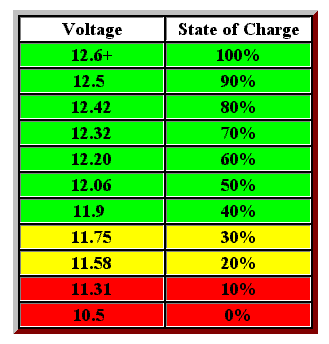...
I had some trouble with mine, but I think it was just corrosion. I left them sit for about 3 weeks without a trickle charger which I usually don't do and they wouldn't even crank to start in 35F weather.
Earlier in the year, I think I sprayed some anti-corrosion on them as an after-thought because they looked so good yet and I was in a hurry after working on some other batteries. Then I promptly forgot about them since they looked done. Then I ended up working in the cold.
With headlights on, one terminal dropped 4+ volts across the post-to-clamp. I thought it a little odd that the truck did not start with the other battery but the system was probably severely undercharging if the alt voltage fooled it as high when it wasn't getting into the batteries. A good cleaning and charge and they seem fine now. I won't really know till spring, or even next fall, as I seldom start it in winter unless the Excursion V-10 is out of service.
I normally trickle charge the batteries constantly when they aren't used. The OEM battery in my previous Ranger sized pick-up lasted about 15 years this way. The idea is to never let the batteries drain down at all and prevent sulphation. When peaked out by a trickle charger, such batteries also seem to crank in winter like in summer. The most common one I used was a $5 sale Harbor Freight unit that was voltage limited, but I also have a couple of $20 Sears sale Schumachers now.
A good source of info is
The 12volt Side of Life (Part 1). Don't miss Part 2.
The chart below is taken from the site:

Using any reasonably accurate digital voltmeter, one can check the percent of charge of RV batteries or, in this case the voltage of the diesel system after the headlights have been on a bit. Good batteries maintain decent voltage longer and a good time to benchmark thee standard battery is now since they are new. Fold the info into your vehicle owners manual. Some years down the road, when you have reason to doubt the batteries integrity, the measurements can be checked against the new battery measurements. Even cranking voltage can be measured so not only the sound, but exact loss can be determined.
Harbor Freight has a small cheap meter, that works and they often sell it for $5, or are even free. I bought one for $3 and gave it to my buddy after I calibrated it against a good Fluke meter. I fine tuned the HF meter on the inside pot to read exact against the Fluke standard, but it was only .1 vdc different, pretty close to start. Then just use the chart above to monitor your RV or parked truck. Best to leave a trickle charger on all the time. I believe batteries sulphate faster in summer.
Wes
...
